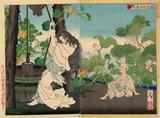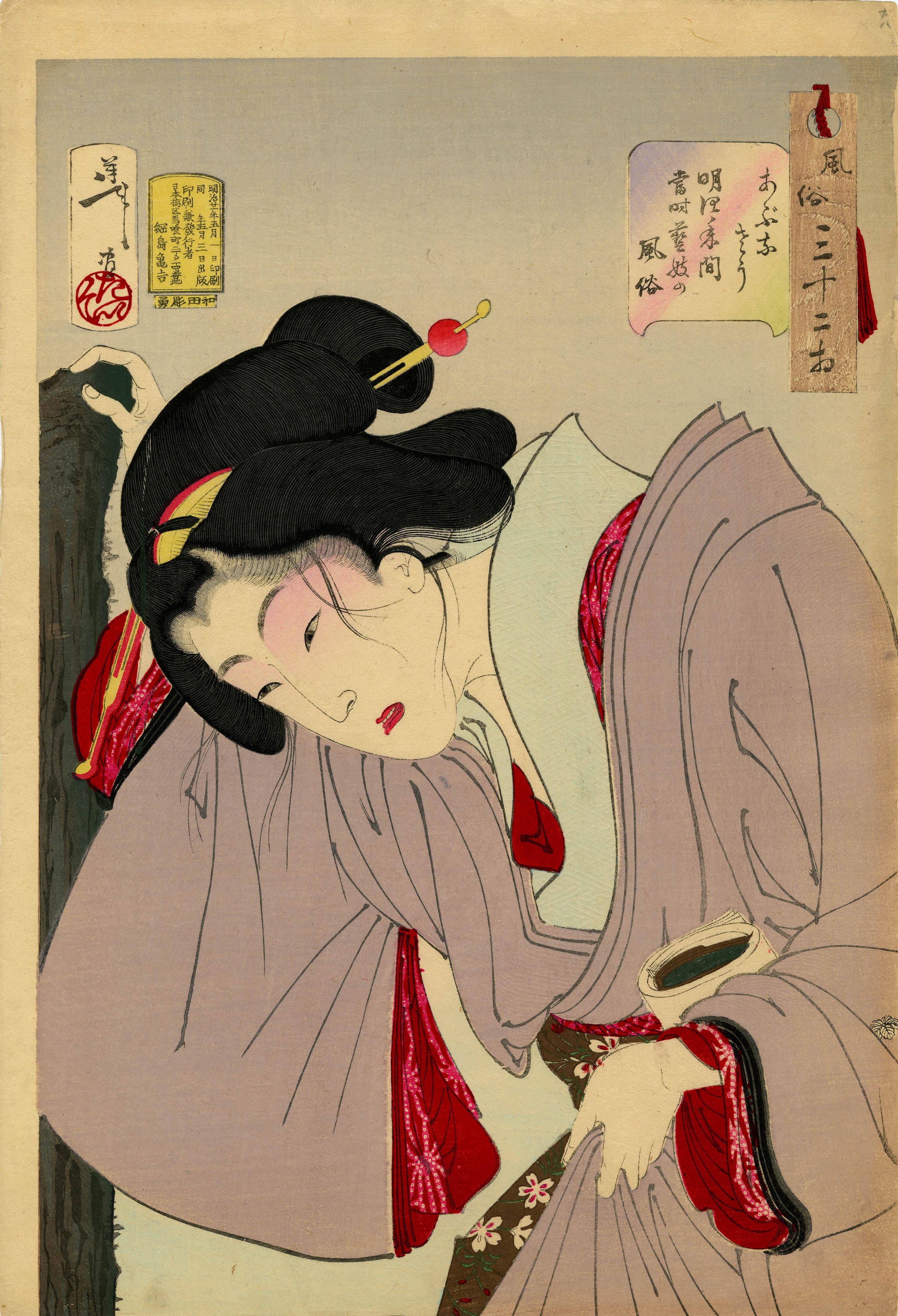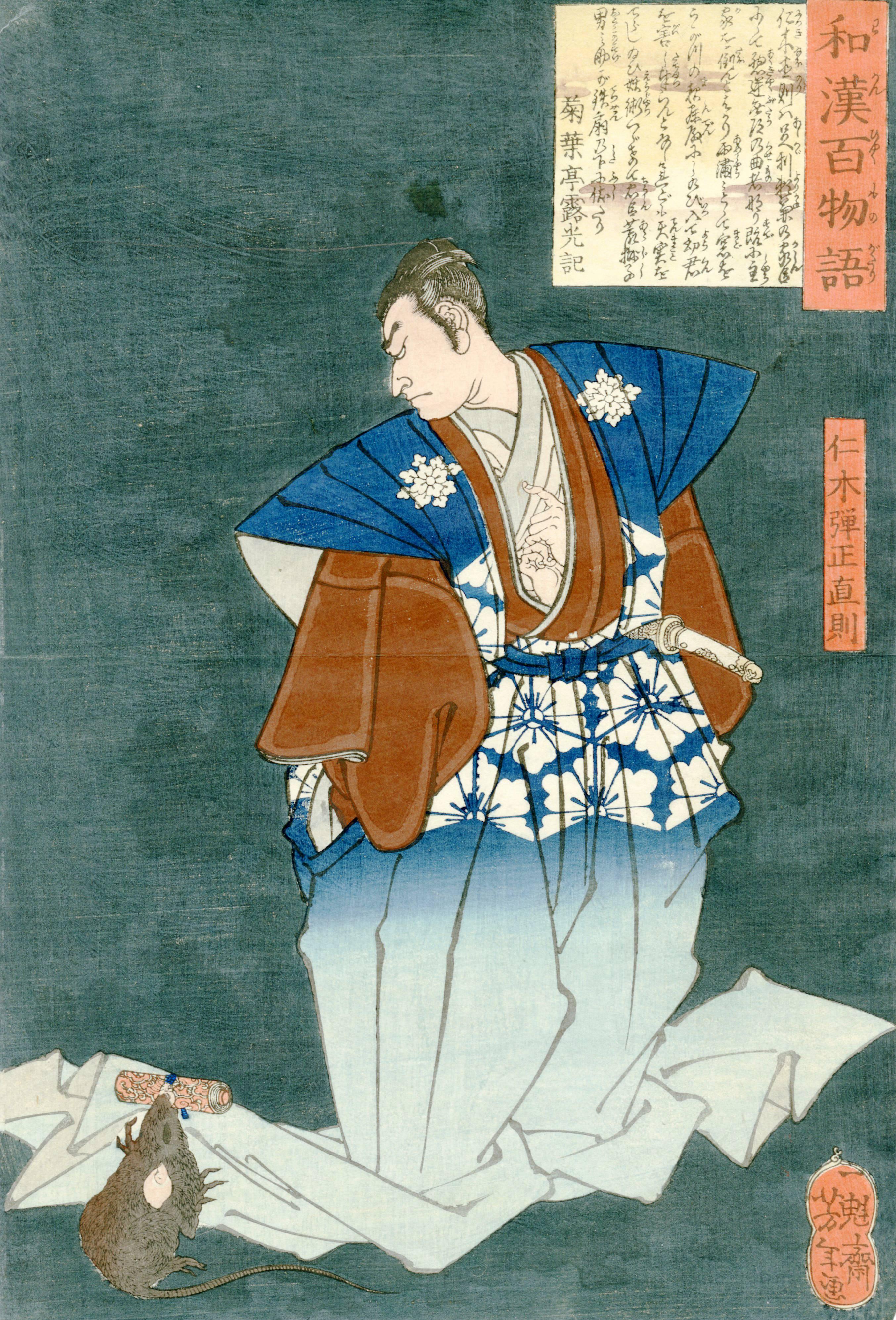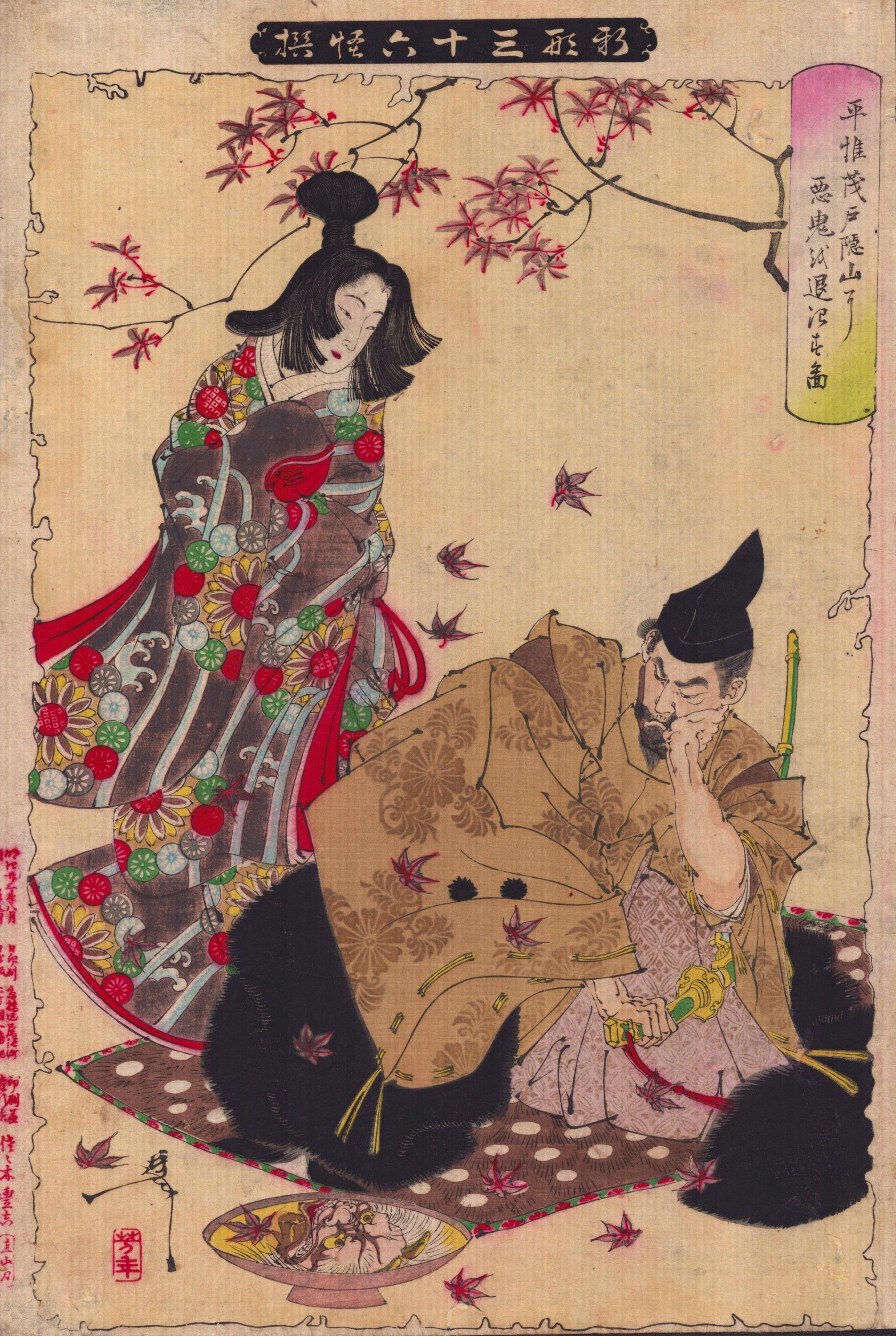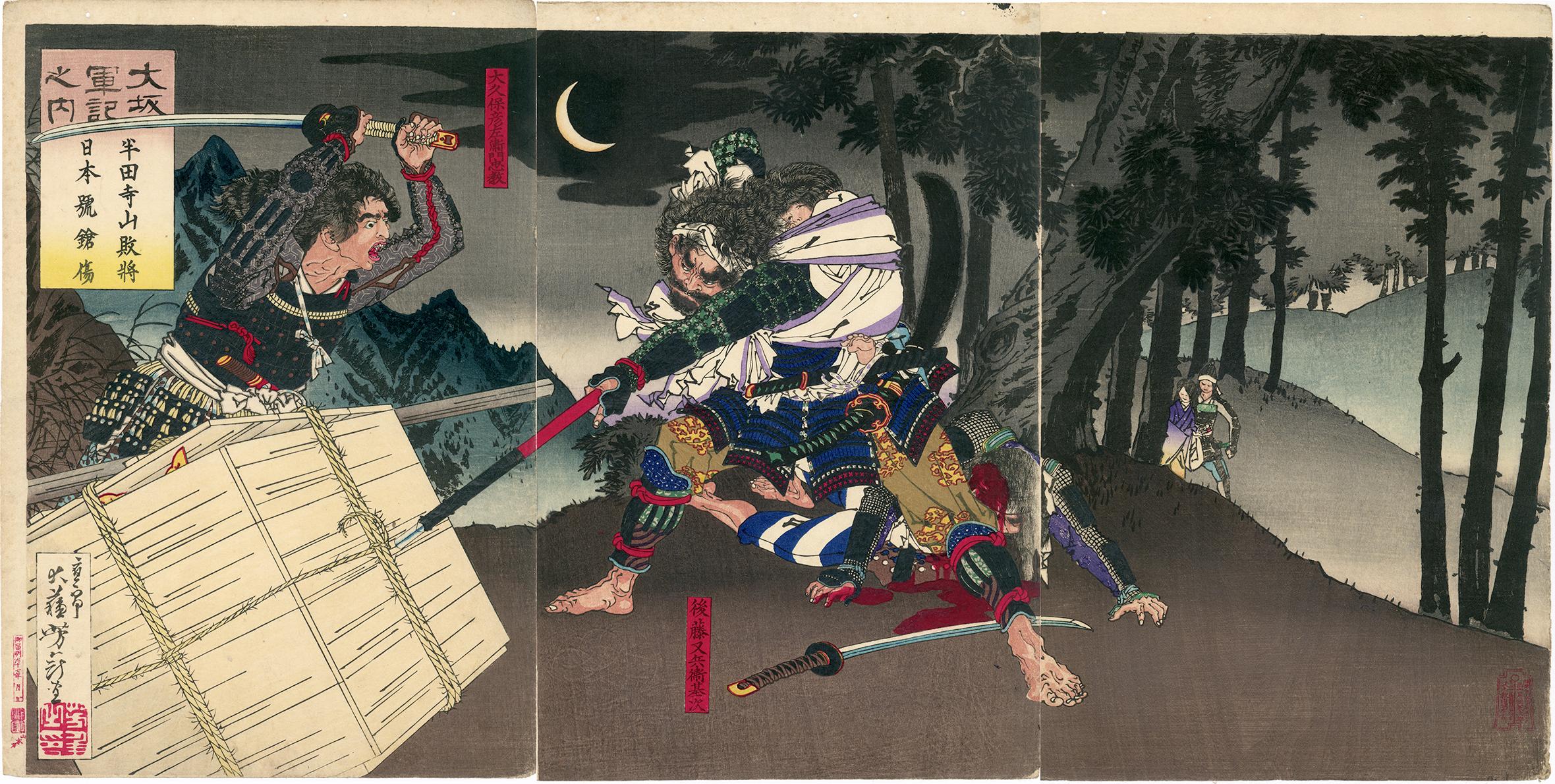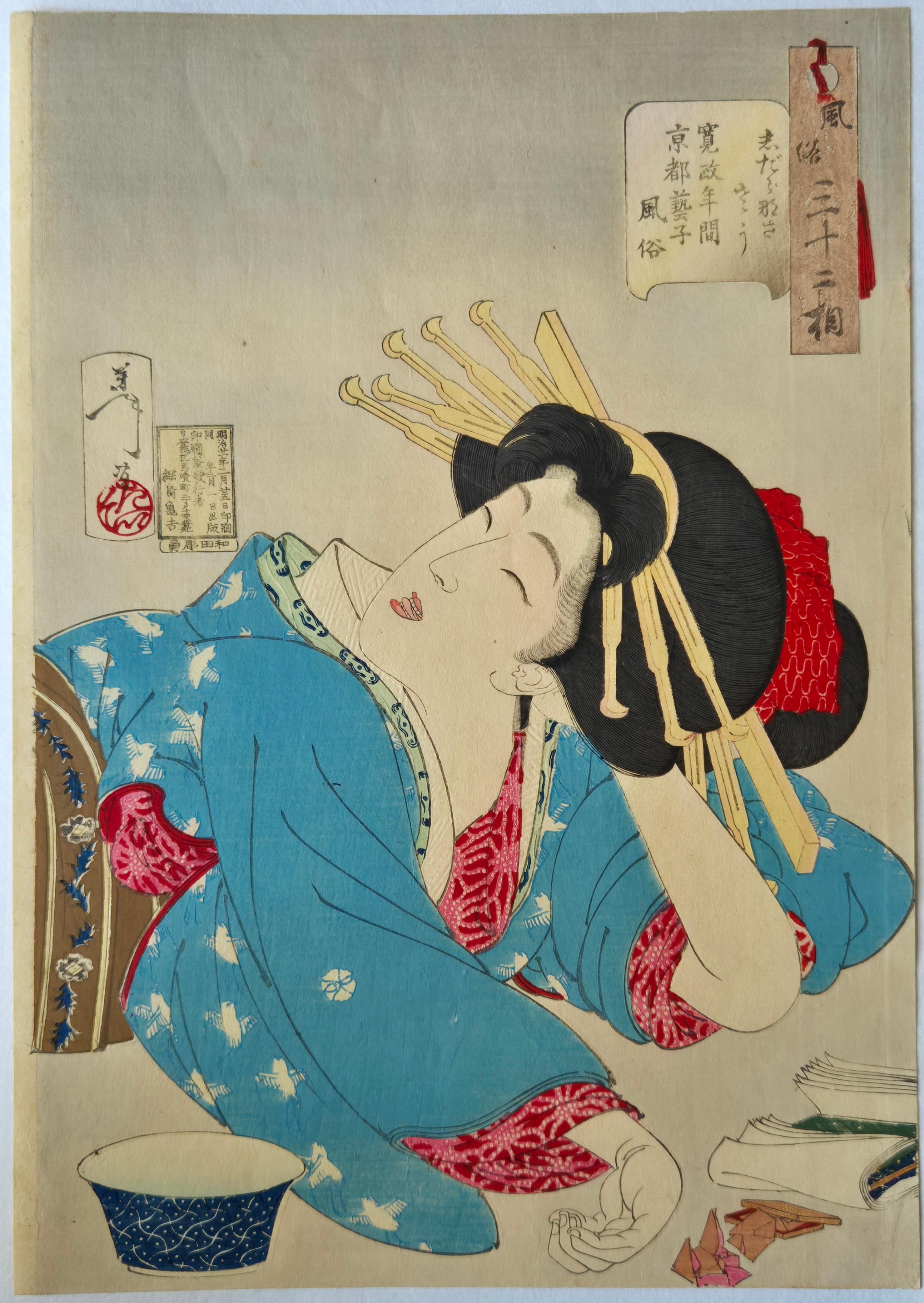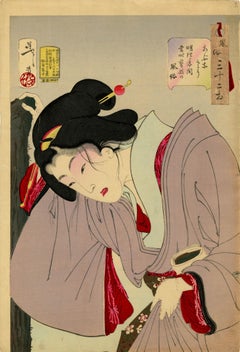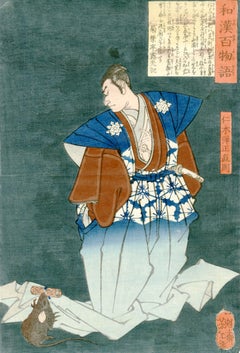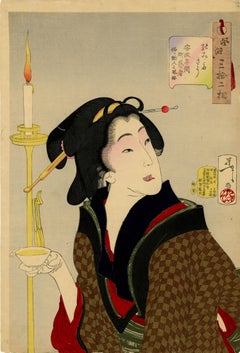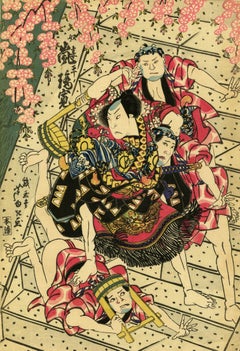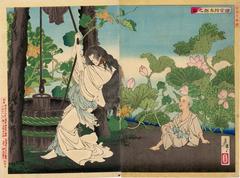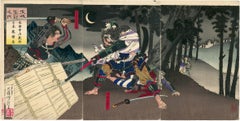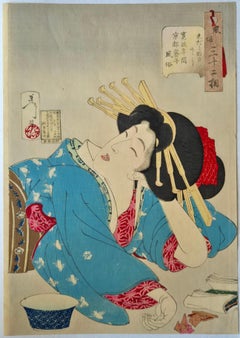Items Similar to The Story of Tamiya Bataro
Want more images or videos?
Request additional images or videos from the seller
1 of 11
Taiso YoshitoshiThe Story of Tamiya Bataro1886
1886
$1,800
£1,373.02
€1,564.28
CA$2,529.92
A$2,760.07
CHF 1,461.44
MX$33,073.52
NOK 18,612.27
SEK 17,019.54
DKK 11,680.26
About the Item
The Story of Tamiya Bataro
Color woodcut diptych, March 22, 1886
Signed and sealed by the artist (see photo) Yoshitoshi signature, Taiso seal
Series: New selection of eastern brocade pictures, Plate 14
Publisher: Tsunajima Kanekichi
This scene depicts Nurse Otsuji hauling water from the well while taking care of Tamiya Bataro.
Condition: Album mounted
Colors fresh
Image size: 14 x 18 1/4 inches
Reference: Beauty and Violence, No. 55.14
Keyes, No. 475
TAISO YOSHITOSHI
(1839-1892)
Taiso Yoshitoshi was born in the city of Edo (now Tokyo) just before Japan’s violent transformation from a medieval to a modern society. In the mid 19th century pressures from the United States and Europe brought an end to Japan’s two hundred years of self-imposed isolation. In 1868 a pivotal period began known as the Meiji Restoration. It was marked by the return of Imperial power, heightened militarism, a new constitution and industrial advancement, as well as social and political reform. In the midst of shifting values, woodblock print artists like Yoshitoshi struggled to create images that would satisfy the public’s changing tastes.
During the Edo period (1600-1868) woodblock prints, or Ukiyo-e (literally “pictures of the floating world”), became one of the most popular and inexpensive visual art forms in Japan. Published in the cities, visitors bought them as souvenirs and gifts from markets and street peddlers and returned with them to remote villages. From the time the first monochrome prints were published in the 1600s, Ukiyo-e represented a unique collaboration between the publisher, the artists and the public. The rising or diminishing interests of the urban merchant class largely dictated the choice of subject matter in woodblock prints.
Yoshitoshi’s confrontation with the savagery and violence of his times, especially early on in his career, was exorcised through a prolific and bloody series of prints depicting battling warriors, demons and murderers. Later in his career, however, Yoshitoshi’s work took on a distinctive stylistic change. By the 1880s, he was experimenting freely with western concepts of space, perspective and dissonant color combinations. His treatment of movement and facial features reflected a more studied and quiet observation of the human form and emotions. While continuing to choose native themes for his prints, Yoshitoshi’s approach to creating individualized portraits of townspeople, farmers, courtesans and warriors was innovative and groundbreaking. However, by the end of the Meiji Period (1868-1912), the increasing popularity of photography and lithography nearly eclipsed the public’s interest in woodblock prints. Yoshitoshi stood alone as the last great master of Ukiyo-e.
Biography courtesy International Folk Art
- Creator:Taiso Yoshitoshi (1839-1892, Japanese)
- Creation Year:1886
- Dimensions:Height: 14 in (35.56 cm)Width: 18.25 in (46.36 cm)
- Medium:
- Period:
- Condition:
- Gallery Location:Fairlawn, OH
- Reference Number:Seller: UK20741stDibs: LU14015162272
About the Seller
5.0
Recognized Seller
These prestigious sellers are industry leaders and represent the highest echelon for item quality and design.
Gold Seller
Premium sellers maintaining a 4.3+ rating and 24-hour response times
Established in 1978
1stDibs seller since 2013
834 sales on 1stDibs
Typical response time: <1 hour
Associations
International Fine Print Dealers Association
- ShippingRetrieving quote...Shipping from: Fairlawn, OH
- Return Policy
More From This Seller
View AllDangerous: The Appearance of a Contemporary Geisha of the Meiji Era
By Taiso Yoshitoshi
Located in Fairlawn, OH
Dangerous: The Appearance of a Contemporary Geisha of the Meiji Era
Color woodcut, 1888
Plate 28 from the series "Thirty-two Aspects of Customs and Manners" (Fuzoku Sanjuniso)
Format...
Category
1880s Figurative Prints
Materials
Woodcut
Nikki Danjo (Naonon)
By Taiso Yoshitoshi
Located in Fairlawn, OH
"One of the main characters of the kabuki play Meiboku Sendai hagi (The Disputed Succession)"
Signed: Ikkaisai Yoshitoshi ga (in gourd shaped cartouche)
Format: oban
Publisher: Da...
Category
1860s Figurative Prints
Materials
Woodcut
Thirsty: The Appearance of a Town Geisha - a So-Called Wine-Server - in the Anse
By Taiso Yoshitoshi
Located in Fairlawn, OH
Thirsty: The Appearance of a Town Geisha - a So-Called Wine-Server - in the Ansei Era
Color woodcut, 1888
Signed; Seal: Taiso (see photo)
Plate 22 from the series "Thirty-two Aspects...
Category
1880s Showa Figurative Prints
Materials
Woodcut
Arashi Rikan II in an Osaka Kabuki Scene
Located in Fairlawn, OH
Arashi Rikan II in an Osaka Kabuki Scene
Color woodcut, c. 1827
Signed middle left (see photo)
Titled upper left (see photo)
Format: oban
Publisher: Honsei
The actor, in character, d...
Category
1820s Other Art Style Figurative Prints
Materials
Woodcut
Inari Kozo Tasaburo- Kabuki
By Utagawa Toyokuni
Located in Fairlawn, OH
Inari Kozo Tasaburo- Kabuki
Color woodcut, c. 1820
Signed: ‘Toyokuni’
Publisher: ‘Yamamoto Heikichi’
Censor: Hama and Magome
Very good impression and color
Sheet/Image size: 15 1/2 x...
Category
1820s Other Art Style Figurative Prints
Materials
Woodcut
Mariko Station, a Mad Caricature (Mariko shukuba no kyoga)
By Kawanabe Kyosai
Located in Fairlawn, OH
Mariko Station, a Mad Caricature (Mariko shukuba no kyoga)
Color woodcut, 1872
Signed in cartouche lower left corner (see photo)
From the series: "53 Stations by Calligraphy and Pain...
Category
1870s Landscape Prints
Materials
Woodcut
You May Also Like
The Boy Botaro and his Nurse Otsuji and a Lotus Pond
By Taiso Yoshitoshi
Located in Burbank, CA
The boy Bôtarô watches his nurse Otsuji haul a bucket of water from the well. From the kabuki play Osanago no adauchi. Most interesting is the lush backdrop of lotus flowers and pump...
Category
1880s Other Art Style Figurative Prints
Materials
Mulberry Paper, Woodcut
Yoshitoshi: Taira no Koremochi Vanquishing the Demon of Mount Togakushi
By Tsukioka Yoshitoshi
Located in BRUCE, ACT
Tsukioka Yoshitoshi
Taira no Koremochi Vanquishing the Demon of Mount Togakushi
From Series: “New Forms of Thirty-six Ghosts”
「新形三十六怪撰」 「平惟茂戸隠山に悪鬼を退治す図」
C. 1890
Size: Oban
Ex...
Category
1890s Figurative Prints
Materials
Woodcut
$1,302 Sale Price
30% Off
Ôkubo Hikozaemon Protects the Hidden Shogun Triptych
By Taiso Yoshitoshi
Located in Burbank, CA
“War Chronicles of Osaka” (Osaka gunki no uchi). Okubo Hikozaemon, raising his sword, protects the hidden Tokugawa shogun from the spear of Gorô Matabei Mototsugu in a moonlit fores...
Category
1880s Other Art Style Figurative Prints
Materials
Mulberry Paper, Woodcut
Tsukioka Yoshitoshi -- Looks Slovenly', Mannerisms of a Kyoto Geisha
By Tsukioka Yoshitoshi
Located in BRUCE, ACT
Tsukioka Yoshitoshi
Looks Slovenly', Mannerisms of a Kyoto Geisha from the Kansei Period from Thirty-Two Daily Scenes (風俗三十二相), 1888
Woodblock print
Oban
The image depicts a geisha...
Category
1880s Prints and Multiples
Materials
Woodcut
Japanese Art Yoshitoshi Tsukioka Woodblock print [No7 Sayo no Tsuki] Ukiyoe
Located in Niiza, JP
Print size: 225 x 330 mm
Sheet size: 270 x 390 mm
"Tsuki Hyakushi Masterpiece Collection “『月百姿傑作撰集』 is a compilation of selected masterpieces
from ”Tsuki Hyakushi"『月百姿』 a masterpi...
Category
20th Century Japanese Prints
Materials
Paper
Tsukioka Yoshitoshi -- Looking Tasty, the Appearance of a Prostitute during the
By Tsukioka Yoshitoshi
Located in BRUCE, ACT
Tsukioka Yoshitoshi
Looking Tasty, the Appearance of a Prostitute during the Kaei Era from Thirty-Two Daily Scenes (風俗三十二相), 1888
Woodblock print
Oban
This piece depicts a woman on...
Category
1880s Prints and Multiples
Materials
Woodcut
More Ways To Browse
Great Seal Of The United States
Kaws Untitled
Keith Haring Best Buddies
Keith Haring David Bowie
Keith Haring Future Primeval
Kin Choi Lam
Kunisada Triptych
La Petite Corrida
Leon Boullet
Leroy Neiman Posters
Lithograph By Mirror
Lithograph Picasso 1957
Make Art Not War
Marc Chagall Poster Framed
Marc Chagall The Lovers
Marino Marini Shakespeare
Mary Cassatt Etchings
Matisse Signed Print
